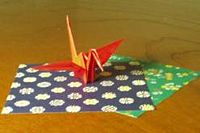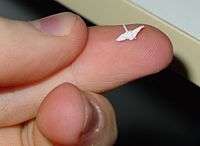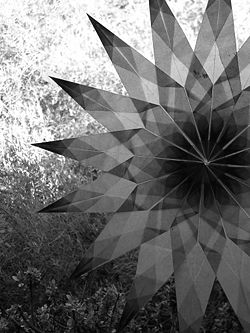Difference between revisions of "Origami" - New World Encyclopedia
Keisuke Noda (talk | contribs) (imported from wiki) |
m ({{Contracted}}) |
||
| Line 1: | Line 1: | ||
| + | {{Contracted}} | ||
{{otheruses4|paper folding|the Microsoft project formerly known as the "Origami Project"|Ultra-Mobile PC}} | {{otheruses4|paper folding|the Microsoft project formerly known as the "Origami Project"|Ultra-Mobile PC}} | ||
Revision as of 21:43, 27 September 2006
- This article is about paper folding. For the Microsoft project formerly known as the "Origami Project", see Ultra-Mobile PC.

Origami (Japanese: 折り紙 ori, to fold, and kami, paper lit. "folding paper") is the art of paper folding. The goal of this art is to create a given result using geometric folds and crease patterns. Origami refers to all types of paper folding, even those of non-Japanese origin.
Origami only uses a small number of different folds, but they can be combined in a variety of ways to make intricate designs. In general, these designs begin with a square sheet of paper, whose sides may be different colors, and usually proceed without cutting the paper. Contrary to most popular belief, traditional Japanese origami, which has been practiced since the Edo era (1603-1867), has often been less strict about these conventions, sometimes cutting the paper during the creation of the design (Kirigami 切り紙) or starting with a rectangular, circular, triangular or other non-square sheets of paper.
History
The origins of origami are disputed, but origami was certainly developed more in Japan than anywhere else. Origami was mostly a traditional art for the amusement of children until Akira Yoshizawa spurred a renaissance of the artform with his new advancements, including wet-folding and the Yoshizawa-Randlett system of diagramming. In the 1960s the art of origami began to spread out, first with modular origami and then with various movements developing, including the kirikomi, purist and pureland schools of thought.
Paper and other materials
Although almost any laminar material can be used for folding, the choice of material used greatly affects the folding and final look of the model.
Normal copy paper with weights of 70–90 g/m² can be used for simple folds, such as the crane and waterbomb. Heavier weight papers of 100 g/m² or more can be wet-folded. This technique allows for a more rounded sculpting of the model, which becomes rigid and sturdy when dry.
Special origami paper, often also referred to as "kami", is sold in prepackaged squares of various sizes ranging from 2.5 cm to 25 cm or more. It is commonly coloured on one side and white on the other; however, dual coloured and patterned versions exist and can be used effectively for colour-changed models. Origami paper weighs slightly less than copy paper, making it suitable for a wider range of models.
Foil-backed paper, just as its name implies, is a sheet of thin foil glued to a sheet of thin paper. Related to this is tissue foil, which is made by gluing a thin piece of tissue to kitchen aluminium foil. A second piece of tissue can be glued onto the reverse side to produce a tissue/foil/tissue sandwich. Foil-backed paper is available commercially but not tissue foil. Both types of foil materials are suitable for complex models.
Artisan papers such as unryu, lokta, hanji, gampi, kozo, saa have long fibres and are often extremely strong. As these papers are floppy to start with, they are often backcoated or resized with methylcellulose or wheat paste before folding. Also, these papers are extremely thin and compressible, allowing for thin, narrowed limbs as in the case of insect models.
Mathematics of origami
The practice and study of origami encapsulates several subjects of mathematical interest. For instance, the problem of flat-foldability (whether a crease pattern can be folded into a 2-dimensional model) has been a topic of considerable mathematical study.
Significantly, paper exhibits zero Gaussian curvature at all points on its surface, and only folds naturally along lines of zero curvature. But the curvature along the surface of a non-folded crease in the paper, as is easily done with wet paper or a fingernail, no longer exhibits this constraint.
Folding a flat model from a crease pattern has been proven by Marshall Bern and Barry Hayes to be NP complete. [1]
The problem of rigid origami ("if we replaced the paper with sheet metal and had hinges in place of the crease lines, could we still fold the model?") has great practical importance. For example, the Miura map fold is a rigid fold that has been used to deploy large solar panel arrays for space satellites.
Technical origami

Technical origami, also known as origami sekkei, is a field of origami that has developed almost hand-in-hand with the field of mathematical origami. In the early days of origami, development of new designs was largely a mix of trial-and-error, luck and serendipity. With advances in origami mathematics however, the basic structure of a new origami model can be theoretically plotted out on paper before any actual folding even occurs. This method of origami design was pioneered by Robert Lang, Meguro Toshiyuki and others, and allows for the creation of extremely complex multi-limbed models such as many-legged centipedes, human figures with full complement of fingers and toes, and the like.
The main starting point for such technical designs is the crease pattern (often abbreviated as 'CP'), which is essentially the layout of the creases required to form the final model. Although not intended as a substitute for diagrams, folding from crease patterns is starting to gain in popularity, partly because of the challenge of being able to 'crack' the pattern, and also partly because the crease pattern is often the only resource available to fold a given model, should the designer choose not to produce diagrams.
Paradoxically enough, when origami designers come up with a crease pattern for a new design, the majority of the smaller creases are relatively unimportant and added only towards the completion of the crease pattern. What is more important is the allocation of regions of the paper and how these are mapped to the structure of the object being designed. For a specific class of origami bases known as 'uniaxial bases', the pattern of allocations is referred to as the 'circle-packing'. Using optimization algorithms, a circle-packing figure can be computed for any uniaxial base of arbitrary complexity. Once this figure is computed, the creases which are then used to obtain the base structure can be added. This is not a unique mathematical process, hence it is possible for two designs to have the same circle-packing, and yet different crease pattern structures
Authors of books about origami
- Akira Yoshizawa - reinvented modern origami. Created the modern repertoire of folding symbols
- Robert J. Lang - Author of many Origami books including the new benchmark Origami Design Secrets
- Peter Engel - influential origami artist and theorist
- Tomoko Fusé - famous for boxes and unit origami
- Robert Harbin - popularised origami in Britain; also presented a series of short programmes entitled Origami, made by Thames Television for ITV
- Kunihiko Kasahara - devised a standardized method for creating any polyhedron
- John Montroll - probably the most prolific Western artist
- Nick Robinson - origami artist and author of over a dozen books on origami
- Toshikazu Kawasaki - Japanese mathematician famous for his Iso-area folding theory and his many geometric folds, including Kawasaki's "Rose"
- Makoto Yamaguchi
- Satoshi Kamiya
Further reading
- Robert J. Lang. The Complete Book of Origami: Step-by-Step Instructions in Over 1000 Diagrams. Dover Publications, Mineola, NY. Copyright 1988 by Robert J. Lang. ISBN 0-486-25837-8 (pbk.)
- Pages 1-30 are an excellent introduction to most of these skills. Each of these 13 models is designed to let you practice one skill several times. Unfortunately, the remaining 24 models leave out lots of pre-creases.
- Tomoko Fuse. Unit Origami: Multidimensional Transformations. Japan Publications, inc. Tokyo. Copyright 1990 by Tomoko Fuse. ISBN 0-87040-852-6
- This is an excellent book about modular origami, and serves as a great introduction to geometric models and designs.
- Kunihiko Kasahara. Origami Omnibus: Paper Folding for Everybody. Japan Publications, inc. Tokyo. Copyright 1988 by Kunihiko Kasahara. ISBN 4-8170-9001-4
- A good book for a more advanced origamian, this book presents many more complicated ideas and theories, although the author tends to go off on long tangents about random topics. Still lots of good models though...
- Kunihiko Kasahara and Toshie Takahama. Origami for the Connoisseur. Japan Publications, inc. Tokyo. Copyright 1987 by Kunihiko Kasahara and Toshie Takahama. ISBN 0-87040-670-1
- Another good book; same comments as the previous author.
- One Thousand Paper Cranes: The Story of Sadako and the Children's Peace Statue by Takayuki Ishii, ISBN 0-440-22843-3
- Sadako and the Thousand Paper Cranes by Eleanor Coerr, ISBN 0-698-11802-2
- Origami 1, Robert Harbin, 1969, ISBN 0-340-10902-5
- Origami 2, Robert Harbin, ISBN 0-340-15384-9
- Origami 3, Robert Harbin, 1972, ISBN 0-340-16655-X
- Origami 4, Robert Harbin, 1977, ISBN 0-340-21822-3 (rare)
- Origami Design Secrets, Robert J. Lang, 2003, ISBN 1-56881-194-2
- Extreme Origami, Kunihiko Kasahara, 2001, ISBN 0-8069-8853-3
- Ariomar Ferreira da Silva. Brincando com Origami Arquitetônico: 16 diagrams. Global Editora, São Paulo, Brazil. Copyright 1991 by Ariomar Ferreira da Silva and Leôncio de O. Carvalho. ISBN 85-260-0273-2
See also
- Modular origami
- Origami techniques
- Mathematics of paper folding
- Chinese paper folding
- Pepakura
- Noshi
- Paper plane
- Kusudama
- Origamic architecture
External links
- OrigamiLarge collection of diagrams, suitable for beginners.
- The Lister List This is a collection of 115 essays by David Lister, one of origami's most eminent historians.
- Robert J. Lang Origami Robert J. Lang is one of the most important origami artists alive today.
- Origami Forum The Online Origami Forum.
- Joseph Wu's Origami Page This popular website has many fascinating and well-documented features.
- The FOLDS.NET Guide to Paperfolding Instructions on the Web
- Ordigami Origami models of computer hardware with crease patterns. Created by Etienne Cliquet.
- Gilad's Origami Page Hundreds of origami book reviews (with pictures) and huge galleries of folded models.
- BARF Bay Area Rapid Folders website
- Oxford Origami Society Student society at the University of Oxford for teaching and promoting the art and science of Origami.
- OrigamiWorldOrigami in English, German and Dutch
- Origami USA's Website The major Origami organization of the United States, make sure to check out their models database.
- British Origami Society
- Origami Austria Official homepage of Origami Austria, available in English and German.
af:Origami ar:أوريغامي ca:Origami cs:Origami da:Origami de:Origami et:Origami es:Origami eo:Origamio eu:Origami fa:اریگامی fr:Origami gl:Origami io:Origamio id:Origami it:Origami he:אוריגמי lt:Origami ms:Origami nl:Origami ja:折り紙 no:Origami nn:Origami pl:Origami pt:Origami ro:Origami ru:Оригами sq:Origami sk:Origami fi:Paperintaittelu sv:Origami th:โอะริงะมิ vi:Origami zh:折紙
{{Credit|77865333}]




